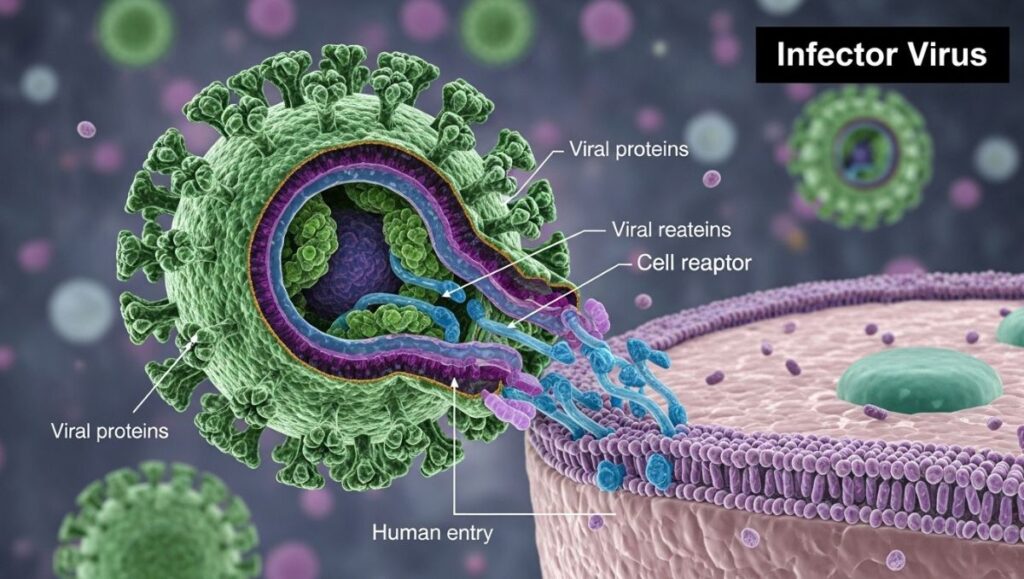Viruses are among the smallest and most powerful biological entities known to science. Despite their microscopic size, they have shaped the course of evolution, health, and even technology. Within the realm of virology, the infector virus is a term that broadly refers to any virus capable of infecting and replicating within a host organism, whether that host is a human, animal, plant, or even a computer system.
In the biological world, infector viruses are responsible for some of the most significant diseases in history — from influenza and HIV to COVID-19 and Ebola. In the digital world, the term infector virus also applies metaphorically to computer viruses that infiltrate and replicate within systems, spreading rapidly across devices and networks.
Understanding how infector viruses function — both biologically and digitally — is essential to protecting human health, data integrity, and the stability of our interconnected world.
What Is an Infector Virus?
An infector virus is a self-replicating entity that relies on infecting a host to survive and multiply. Unlike bacteria, viruses cannot reproduce independently. They hijack the molecular machinery of their hosts to make copies of themselves, often damaging or destroying host cells in the process.
In the context of biology, an infector virus enters living cells, injects its genetic material (DNA or RNA), and uses the cell’s replication mechanisms to produce more viral particles. The newly created viruses then spread to other cells, continuing the infection cycle.
In computer science, an infector virus functions in a similar conceptual way — it infects executable files or system programs, replicating itself whenever those files are run, and spreading to new systems through networks, email attachments, or removable drives.
Types of Infector Viruses (Biological)
Biological infector viruses come in many forms, classified based on their structure, genome type, and replication method. The following are some major categories:
1. DNA Viruses
These viruses contain DNA as their genetic material. They typically replicate within the host cell’s nucleus and often have complex replication strategies.
Examples: Herpesviruses, Adenoviruses, and Poxviruses.
2. RNA Viruses
RNA viruses carry RNA as their genetic material. They replicate directly in the cytoplasm and often mutate rapidly, leading to new strains.
Examples: Influenza virus, Coronavirus (SARS-CoV-2), and HIV.
3. Retroviruses
Retroviruses are a subclass of RNA viruses that use a special enzyme called reverse transcriptase to convert their RNA into DNA, which then integrates into the host genome.
Example: Human Immunodeficiency Virus (HIV).
4. Bacteriophages
Bacteriophages are viruses that infect bacteria. They play a crucial role in microbial ecology and have growing importance in medicine as alternatives to antibiotics.
Example: T4 phage that infects E. coli.
5. Zoonotic Viruses
These are viruses that jump from animals to humans. They are often responsible for new disease outbreaks.
Examples: Ebola, Hantavirus, and certain strains of Influenza.
How Biological Infector Viruses Spread
The spread of infector viruses depends on the type of host and the nature of the virus itself. Common transmission routes include:
-
Airborne Transmission: Through droplets from coughing, sneezing, or breathing (e.g., influenza, COVID-19).
-
Contact Transmission: Via contaminated surfaces or direct touch (e.g., norovirus, herpes).
-
Vector-Borne Transmission: Through insects such as mosquitoes or ticks (e.g., Zika, dengue, yellow fever).
-
Waterborne Transmission: Through contaminated water sources (e.g., rotavirus, hepatitis A).
-
Sexual Transmission: Through bodily fluids (e.g., HIV, HPV).
-
Bloodborne Transmission: Through transfusions or shared needles (e.g., hepatitis B, Ebola).
Each mode of transmission requires specific preventive strategies — from vaccination and hygiene to public health interventions.
The Infection Cycle: How Infector Viruses Operate
Viruses follow a basic infection and replication cycle that includes several key stages:
1. Attachment
The virus identifies and binds to specific receptors on the surface of a host cell. This specificity determines which cells or species the virus can infect.
2. Penetration
Once attached, the virus enters the host cell — either by direct fusion with the cell membrane or by being engulfed through a process called endocytosis.
3. Replication and Assembly
Inside the cell, the virus releases its genetic material, hijacking the cell’s machinery to synthesize viral proteins and genetic copies. These components are then assembled into new viral particles.
4. Release
Newly formed viruses are released from the host cell — often destroying it in the process — to infect other cells and continue the cycle.
This process occurs rapidly, allowing infector viruses to multiply exponentially in a short time, often overwhelming the host’s immune system.
Symptoms and Effects of Infector Viruses (in Humans)
Symptoms vary depending on the virus type, the site of infection, and the host’s immune response. Common symptoms of viral infection include:
-
Fever and chills
-
Fatigue and muscle aches
-
Cough, sore throat, or respiratory distress
-
Nausea, vomiting, and diarrhea
-
Rash or skin eruptions
-
Neurological symptoms (in severe cases)
Some viruses cause acute infections, which resolve quickly (e.g., flu), while others lead to chronic infections that persist for years (e.g., HIV, hepatitis B).
Infector Virus vs. Computer Virus
The term “infector virus” is also widely used in cybersecurity to describe self-replicating malicious software that infects executable files and programs.
1. File Infector Viruses
These are computer viruses that attach themselves to executable programs (.exe or .com files). When the infected file runs, the virus activates and spreads.
Examples: CIH (Chernobyl virus), Jerusalem virus.
2. Boot Sector Infector Viruses
These target the boot sector of a computer’s hard drive or removable media. When the system starts, the virus loads into memory before the operating system.
Example: Michelangelo virus.
3. Macro Infector Viruses
These exploit document macros (like those in Microsoft Word or Excel) to spread malicious code.
Example: Melissa virus.
4. Network or Worm-Like Infectors
These viruses spread automatically across networks without user intervention, mimicking biological contagion.
Example: WannaCry ransomware (which uses viral propagation methods).
How Computer Infector Viruses Spread
-
Email Attachments: Users unknowingly open infected files.
-
USB Drives or External Devices: Viruses transfer when devices are connected to multiple systems.
-
Network Sharing: Infected files propagate across corporate or home networks.
-
Software Downloads: Malicious software disguised as legitimate applications.
Just like biological viruses, computer infectors exploit vulnerabilities to reproduce and spread rapidly.
Prevention and Control of Infector Viruses
Whether biological or digital, controlling infector viruses requires vigilance, hygiene, and technology. Below are preventive measures for both realms:
Biological Virus Prevention
-
Vaccination: One of the most effective methods to build immunity and prevent viral spread.
-
Hygiene Practices: Regular handwashing, disinfection of surfaces, and proper sanitation.
-
Masking and Distancing: Reduces airborne transmission in pandemics.
-
Vector Control: Managing mosquitoes, ticks, and other carriers.
-
Public Health Surveillance: Monitoring and early detection of outbreaks.
-
Antiviral Medications: Inhibiting viral replication in infected patients (e.g., Tamiflu, antiretrovirals).
Computer Virus Prevention
-
Use of Antivirus Software: Regular scanning and malware protection.
-
System Updates: Patching vulnerabilities in operating systems and applications.
-
Avoiding Suspicious Links and Emails: Preventing social engineering attacks.
-
Backup Systems: Regular data backups to prevent data loss.
-
Firewalls and Encryption: Enhancing system security to block unauthorized access.
Both types of “infector viruses” demonstrate how prevention is more effective — and less costly — than cure.
Global Impact of Infector Viruses
Health Impact
Infector viruses have caused global pandemics that changed human history — such as the Spanish Flu (1918), HIV/AIDS crisis, and COVID-19 pandemic. These events reveal how interconnected global health, economics, and technology truly are.
Economic Impact
Viral outbreaks can cripple economies, disrupt supply chains, and strain healthcare systems. Similarly, computer viruses cost organizations billions annually through data breaches, ransomware, and downtime.
Technological and Scientific Advancement
Ironically, infector viruses have also driven progress. The study of viruses has led to innovations in:
-
Vaccine development (mRNA technology)
-
Gene therapy using viral vectors
-
Cybersecurity advancements inspired by biological defense models
Infector Viruses in Research and Biotechnology
Scientists use modified infector viruses in biotechnology and medicine for beneficial purposes. These include:
-
Gene Therapy: Viruses are engineered to deliver healthy genes into patients’ cells.
-
Vaccine Development: Weakened or inactive viruses serve as the basis for immunization.
-
Oncolytic Viruses: Special viruses that target and destroy cancer cells.
-
Nanomedicine and Drug Delivery: Viral mechanisms inspire efficient molecular transport systems.
Thus, while infector viruses can cause harm, they also hold immense potential for healing and innovation when harnessed responsibly.
The Future: Living with and Learning from Viruses
As science advances, humanity’s relationship with viruses continues to evolve. Researchers are working toward universal vaccines, AI-based outbreak prediction, and synthetic virology — areas that may redefine how we live alongside these microscopic entities.
In cybersecurity, adaptive AI systems are being developed to detect and neutralize digital infector viruses before they spread.
The key to both biological and digital safety lies in resilience, education, and rapid response systems that anticipate threats rather than simply reacting to them.
Conclusion
The concept of an infector virus transcends biology and technology — representing a universal mechanism of invasion, replication, and adaptation. Whether in a human body or a computer system, infector viruses remind us of the delicate balance between vulnerability and defense.
By studying their behavior, improving our prevention strategies, and leveraging technology for good, we can coexist with these agents of change — transforming them from threats into tools of discovery and progress.






